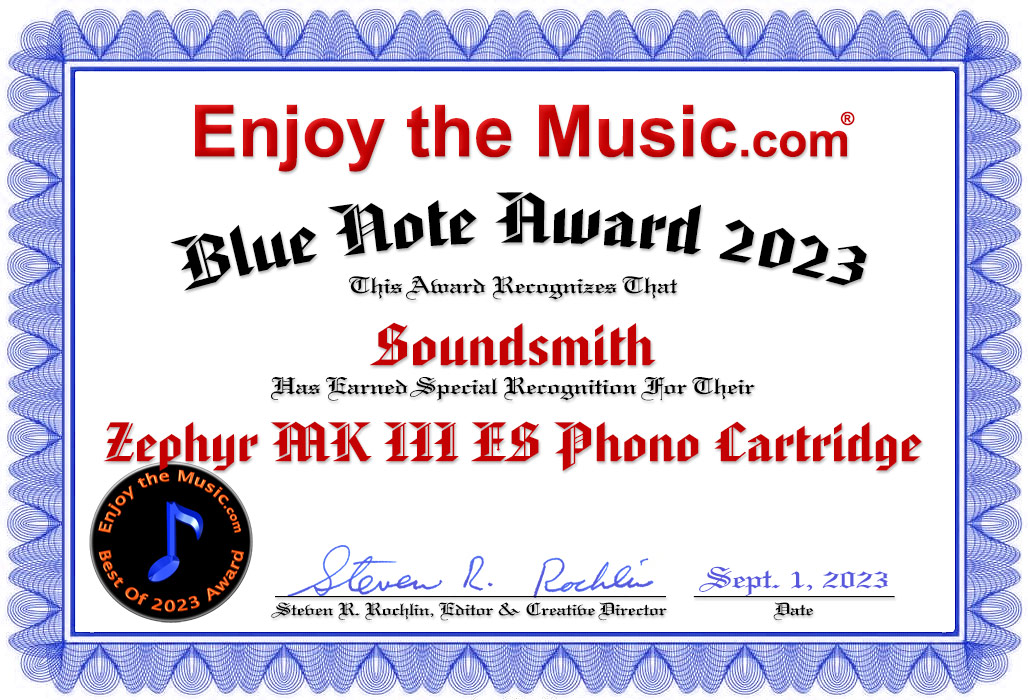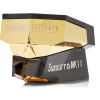Soundsmith Carmen and MMP3 Phono Stage

 "The Soundsmith Carmen's ultra-low-mass MI assembly plays with more agility, is more naturally detailed, and sounds less stressed than any MC I'm aware of. Its treble is not dull or rolled off—it's just the most authentic treble I've experienced from a phonographic transducer."
"The Soundsmith Carmen's ultra-low-mass MI assembly plays with more agility, is more naturally detailed, and sounds less stressed than any MC I'm aware of. Its treble is not dull or rolled off—it's just the most authentic treble I've experienced from a phonographic transducer."
- Herb Recihert, Stereophile
So, audiophiles, riddle me this: What does a DAC actually look like? I don't mean the box it hides in—I mean the little doodad that does the actual converting from digital to analog. Is it bigger than a phono cartridge? Is it made of rain-forest wood, gemstone, or porcelain? Do people show it to their friends, who gawk in awe and envy? Does it have an exotic, geisha-sounding name like Jasmine Tiger, Koetsu Onyx, or Miyajima Takumi? When it breaks, does a watchmaker type rebuild it for a not-insubstantial fee? Do people hoard them in vaults, like NOS tubes? Can you trade a DAC for a rose-gold Rolex Oyster Bubbleback ca 1945?
I didn't think so.
Then perhaps you can understand why I spend so much time in the floating world of gramophone dreams. What in audio is more beautiful than a snakewood Schröder, a crinkle-painted Gray 108, or an Abis SA-1 tonearm? What could be more exotic than a Pierre Clément or a Mitchell Cotter turntable? It is my full intention to spend the rest of my days aligning phono cartridges and slipping black discs (with richly colored labels) from their yellowing paper sleeves.
Even more than the artful beauty of cartridges, tonearms, and turntables themselves, I admire the fabled engineers who design and build these musical devices. When I recall the history of record-playing machines, I run into names like Joseph Grado (1924–2015), the first person I ever associated with artisanal audio products. My next hi-fi idol was the venerable Yoshiaki Sugano (1907–2002), descended from an ancient family of Japanese poets, painters, potters, and sword makers. A painter himself, Sugano-san could trace his lineage to a 16th-century master calligrapher-painter, Hon'ami Koetsu, after whom he named his own most illustrious phono cartridges. In my memory, Sugano was the beginning of not only artisanal high-end cartridge manufacturing, but was also the master who introduced beauty and connoisseurship to hi-fi. He made Marantz and McIntosh models seem ordinary and industrial. By designing cartridges that had cobalt-based magnets, coils of 99.9999%-pure copper, boron cantilevers, and bodies of rosewood, ebony, or onyx, he demonstrated to the entire audio world that all things physical resonate in accordance and harmony with the materials they are made from. The Sugano-designed Koetsu Rosewood Signature cartridge was the first of my romantic affairs with exotic (and expensive) audio bits. It was also the first cartridge to sell for more than $1000.
After Yoshiaki Sugano, I connected with the even more esoteric creations of Hiroyasu Kondo, of Audio Note Japan. Kondo-san brought low-compliance, low-output moving-coil (MC) cartridges to new levels of poetic naturalness of sound. He made his coils of superfine wire drawn by hand at low temperatures from ingots of pure Italian silver. His best cartridge, the Io Ltd., needed 0.5 amp to power its perfectly matched field coils, which replaced the permanent magnets used in more conventional designs. The Io Ltd. sold for $30,000.
The super-cartridge era may have begun in 1973, when Holland's A.J. van den Hul developed the completely new and highly effective Type I stylus profile, which reduced the standard stylus horizontal radius of 18µm to 2µm. I remember how some people were afraid to use it, thinking it would damage their records. I remember paying van den Hul what seemed an awful lot of money to retip my Koetsu Rosewood Signature. When I got it back, it no longer sounded like the Alice in Wonderland Koetsu I'd sent him—and I didn't care. That Type I stylus dug out more spatial, soundstage, and image information than I'd ever heard. (I occasionally wonder if those vdH styli and the BBC's stand-mounted LS3/5A speakers didn't conspire to usher in our ideas of soundstage and imaging in high-end audio.) A.J. van den Hul parlayed his exciting invention into a sophisticated operation that sold over a million styli to companies like Ortofon, Goldring, and Audio Note, while making his own highly esteemed MC cartridges with such fun names as Grasshopper and Frog.
I could go on and on, telling inspiring stories about such cartridge legends as Per Windfeld and Leif Johannsen at Ortofon (Denmark), Jonathan Carr and Stig Borge of Lyra (Tokyo), or the Suchy family of Clearaudio (Germany). But this month I want to keep you on American soil and focus your attention on a supersmart, highly skilled cartridge iconoclast who stands alone and separate from the international cartridge-making guild.
Soundsmith Carmen moving-iron cartridge
Last summer, a friend asked, "So, Herb, how does it feel to be back in audio?"
I didn't have to think. I told him I felt very much at home, and was looking forward to meeting all of those eccentric, Mensa-type designers I hadn't met in my first go-round. I explained that three names proudly stood at the top of my hi-fi fan-boy list: Nelson Pass, Andrew Jones—and Peter Ledermann, whose company, The Soundsmith, is based in Peekskill, New York. Why Ledermann? Because I intuitively felt that his work represented a value system similar to my own. I was inspired by Michael Fremer's words in the April 2008 Stereophile: "Ledermann is more a dreamer and idealist than a schemer." And if you haven't already guessed, dreamers are my people.
When I walked into the Soundsmith room at the 2014 Capital Audio Fest, I knew instantly: This was not "hi-fi," but something more earthbound and real. I asked Ledermann about the speakers. They sounded liquid and full, and energized the room in an extremely provocative way. Instrumental tones and textures grabbed me by the shoulders and insisted that I stop thinking and listen. But Ledermann didn't want to talk about the speakers.
Then my eyes locked on to the blue lights. There was this Blade Runner thing with rows of blue lights tracing the grooves of a rotating black disc. It was a Soundsmith strain-gauge cartridge, and it was playing music with a type of grainless charm I had experienced only from the Jon Iverson (the Electron Kinetics EK-1) and Sao Win (the Win Labs SMC-10) adaptations of the original Panasonic EPC-451C strain-gauge cartridge (footnote 1).
As I said, Peter Ledermann stands alone and apart, and the sound in his room at CAF was proof of that. I don't know of anyone else building or promoting strain-gauge technology, or of anyone other than the Grados and Ledermann who is building moving-iron cartridges. Moving-iron (MI) cartridges are almost the same as moving-magnet (MM) cartridges except that, instead of the stylus-cantilever assembly wiggling a tiny permanent magnet between fixed coils, MIs wiggle a much lighter bit of pure iron in a gapped structure of fixed coils and permanent magnets. The less mass the stylus and cantilever must move, the better the cartridge's transient response and trackability.
I've owned a lot of Grado MIs, and have always enjoyed their musical balance and good tracking. But my favorite MCs played music with more vividness and visceral excitement than any Grado. MCs were my reference for highest-quality LP playback—until I heard records played with a Soundsmith Sussurro MI, which (inspired by tonearm designer Frank Schröder) features ultralow effective moving mass, low voltage output, and a ruby-crystal cantilever with a nude line-contact diamond stylus. I heard the Sussurro only briefly, but I remember thinking, This could be the best cartridge that ever was! (footnote 2).
When I visited the Soundsmith room at the 2014 Rocky Mountain Audio Fest, I told Ledermann of my experience with the Sussurro and my excitement about his designs. I said that I believed he was on to something really extraordinary, and that I needed to know more about it. I explained that my beat was high-value/lower-cost analog gear, and that I hoped he made another cartridge that was maybe almost as amazing as the Sussurro ($4800), but at a price a less wealthy record collector could afford. He showed me a brochure and began to explain the virtues of the Soundsmith Carmen ($799.95). As I listened, I began to scheme. Maybe this could be my step up and away from those Ortofons, Denons, and Grados . . . My mind is a sieve, but I think one of my next sentences began with "Please, please, please . . ."
The Carmen is an ebony-bodied replacement for Soundsmith's esteemed SMMC3 MI model (now discontinued, footnote 3). It is of medium mass (6.8gm), medium compliance (22µm/mN), and high output (2.2mV RMS), and features a nude elliptical stylus (6 by 17µm) and an aluminum-alloy cantilever. It should work well with most MM phono stages and tonearms of low to medium mass. I used the Carmen with a vertical tracking force (VTF) of 1.5gm into a 47k ohms/100pF load (though I recommend experimenting with capacitive loads of up to 450pF). I played it every day for almost six months, with four tonearms and no fewer than five phono stages, including Soundsmith's own matching MMP3 ($649.95).
Soundsmith MMP3 moving-magnet phono stage
Because I received the MMP3 phono stage first, I used it with an Ortofon 2M Black and my Grado M+ Mono and 78rpm cartridges. I'm very familiar with these cartridges so I had a chance to examine the effect this tiny, dead-quiet, solid-state black box had on their sounds. With the Ortofon and Grados, the MMP3 leaned a little toward soft and dark, and a lot toward invisible. The MMP3 barely ever revealed itself in the music or on my equipment rack. It didn't add or subtract noticeably from the character of the transducers it amplified. Using a carefully aligned Ortofon 2M Black ($799) with its vertical tracking angle (VTA) and stylus rake angle (SRA) optimized, I compared the MMP3 directly with Schiit Audio's Mani MM phono stage ($129), the Blue Horizon ProFono ($1299), and the LFD Phonostage ($1299). The Schiit played beautifully, but the MMP3 was a tad more quiet and refined. The Soundsmith was less detailed, forceful, and exciting than the Blue Horizon. The MMP3 and the LFD had surprisingly similar sounds, but the LFD added some instrumental weight that I felt the Soundsmith missed.
Listening to the Carmen
The Carmen was conspicuously chameleon-like. Its sound was always enjoyable, but changed character radically with each tonearm, turntable, and phono stage I connected it to. This is why I do not trust equipment reviews—including mine—to provide more than a sketch of any component's potential. All I could do was install the Soundsmith Carmen in a variety of record-playing systems and report what I heard.
VPI Traveler turntable and tonearm: I began with the Carmen on the VPI Traveler, where it showed itself to be sonically nobler than its ride. The Traveler is an admirable entry-level turntable that distinguishes itself mostly by the sins it fails to commit. Its greatest strengths are its (relative) quietness and the way its combination of rubber mat and aluminum platter seems to drag out the best from budget cartridges like the Ortofon 2M Red. With the Carmen on the Traveler, I fiddled endlessly with VTA and SRA, to no avail—I couldn't get enough detail, soundstage, or boogie factor. On the Traveler's medium-mass tonearm, the Carmen sounded dark and hollow.
Thorens TD-124 turntable and SME 3009II tonearm: When I moved the Carmen from the VPI to the vintage Thorens-SME combination, it was like the sun reappearing from behind a cloud.
Like Peter Ledermann, Beethoven's mysterious Triple Concerto occupies a place apart. I recently discovered a hypnotizing 1970 recording with violinist David Oistrakh, cellist Mstislav Rostropovich, and pianist Sviatoslav Richter, with Herbert von Karajan conducting the Berlin Philharmonic (LP, Angel S-36727). The first thing I noticed was how, even at the quietest volume levels, sparkle and dynamics were preserved. The recording was made in the Jesus-Christus-Kirche in Berlin's Dahlem district, and the Carmen let me feel some of the fierce concentration recorded within those walls. Layered, glowing images of the soloists and orchestra appeared naturally between my speakers. What the Carmen did with Beethoven's quiet passages made me smile and let out my breath. Instrumental scale and tonal contrasts were just right. When the orchestra swelled, my chest followed with anticipation. My dreams of Sussurro-like magic were beginning to unfold.
Pioneer PLX-1000 turntable and tonearm: I'll never forget the first time I heard The Fantasy Film World of Bernard Herrmann, a Decca/London Phase 4 recording engineered by Arthur Lilley (LP, London SP 44207). It was a high-fidelity, paradigm-shifting moment. Decca created the Phase 4 sublabel in the 1960s, to appeal to the burgeoning audiophile market. The Phase 4 sound was admirably clear and wide range, with deep bass and extreme textures enhanced by close miking techniques using 10 or even 20 tracks. On this famous example, Bernard Herrmann conducts the National Philharmonic Orchestra in his own scores for The Day the Earth Stood Still, Fahrenheit 451, and my favorite, The Seventh Voyage of Sinbad. On any but the most amiable systems, this record will bite and slash your ears. This large-scale hi-fi spectacular has no sort of softness or natural acoustic. The first time I heard Phase 4, I compared it to Flying Monkeys with Claws.
Years later, I listened to this LP with a Koetsu Rosewood Signature on a Linn LP12 turntable and immediately became addicted to its textured bass, thundering organ, plucked harp, and resounding timpani. With the Soundsmith Carmen on the Pioneer PLX-1000, which I reviewed in the March 2015 issue, Phase 4's massed strings and loud horns didn't make me reach for the volume control. The sound was smooth and unfatiguing, yet more vivid than I'd ever heard it. Cowbells never sounded better. Tubas were perfect. Tempos were glorious and driving. The deep organ notes in Journey to the Centre of the Earth had authentic tone and glass-rattling authority. Most of all, the Carmen let my mind reach beyond the Phase 4 fireworks to access some of the mystery in Herrmann's classic film scores.
Blue Horizon ProFono phono stage: I played the Carmen mostly with the Soundsmith MMP3 phono stage because that combination did the best vanishing act and sounded the most organic. With the Herrmann Phase 4 disc, the Carmen-MMP3 combo did the best job ever of removing high-frequency bite without reducing the textures of the violins or smoothing their leading edges. Replacing the MMP3 with the ProFono enhanced the Carmen's verity and temporality (which I liked) and added some focus to the soundstage and images (also good), while simultaneously increasing the opacity of those images (which I didn't like).
Acoustic Signature Wow XL turntable and TA-100 tonearm: Mounting the Carmen on the German-made Acoustic Signature Wow XL ($2300) and TA-1000 ($1500)—review in progress—took everything to a much higher level of wonderfulness. The bass became John Henry–like. Images grew hypercrystalline. Midrange textures were enhanced. Forward momentum was unstoppable. I doubt either Arty or Mikey will use this setup as his new reference—but I will.
Welcome to the next level
At this point, I've played hundreds of records with this ebony-bodied wonder, and I think I'm finally starting to grasp some of the inner beauty of Peter Ledermann's inventions. The Soundsmith Carmen's ultra-low-mass MI assembly plays with more agility, is more naturally detailed, and sounds less stressed than any MC I'm aware of. Its treble is not dull or rolled off—it's just the most authentic treble I've experienced from a phonographic transducer. As the Carmen appears to demonstrate, high frequencies reproduced with this level of fidelity improve the character of every octave below them—especially the texture of the midrange and the tunefulness of the bass.
Beyond the Carmen's lower moving mass, I can only speculate about the real causes of all this excellence: In MCs, the coil wires that attach to the back of the cantilever may act as torsion bars, which, I imagine, will affect the movement of the cantilever, or generate voltages in a nonlinear or "reactionary" way. The effects of this mass, energy, and torsion may include some nonlinear inconsistencies in the reproduction of the highest and lowest frequencies of the audioband. The Carmen exhibited none of this.
I'm always on the hunt for cartridges that sound colorful, sensual, visceral, and detailed—and are easy on my mind and wallet. The humble Soundsmith Carmen did and was all of that, which means that it plays with the best cartridges of my experience. Peter Ledermann's designs don't sound like any MC, MM, or MI cartridge I've heard. They stand apart. The only cartridge I could realistically compare to the Sussurro or Carmen would be the blatantly psychedelic Koetsu. More important, Soundsmith's $799.95 Carmen offers a huge chunk of the $4800 Sussurro's magic, for only a small chunk of cash (footnote 4).
Footnote 1: The first "semiconductor phono cartridge" (ie, strain gauge) was developed in the 1960s by a company called Euphonic, whose Miniconic TK-15-LS Phono System was developed as an inexpensive plug-in replacement for aging and broken crystal cartridges. The Miniconic's chief virtue was that it didn't require an RIAA network.
Footnote 2: The Soundsmith Sussurro was reviewed by Michael Fremer in "Analog Corner," March 2012, Vol.35 No.3.
Footnote 3: The earlier Soundsmith SMMC1 was reviewed by Michael Fremer in the April 2008 issue, Vol.31 No.4.
Footnote 4: The Soundsmith, 8 John Walsh Boulevard, Suite 417, Peekskill, NY 10566. Tel: (914) 739-2885, (800) 942-8009. Fax: (914) 739-5204.









